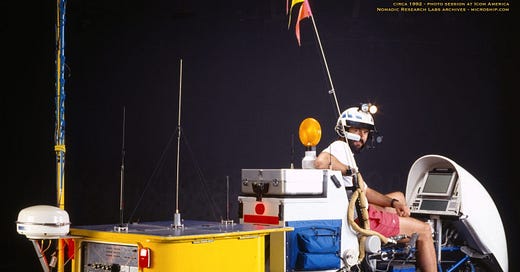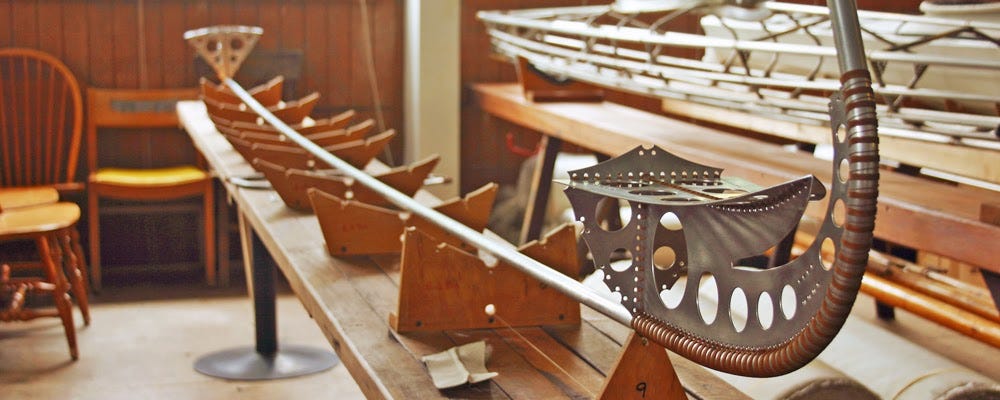Spencer Wright (SW) runs The Prepared, a very good (and interesting!) newsletter about engineering, manufacturing, and infrastructure. A former strategy consultant and one-time whistling champion, he’s now found in central Brooklyn, hauling kids and tools around by bike. -Colin (CJN)
Spencer here. When humans choose to live by sea, they do so in a largely self-regulated way. Admiralty law does, of course, cover the big stuff: injury, theft, and certain types of contract disputes. But the vast majority of what people do in the water is travel, and traveling by water is a decidedly laissez-faire enterprise.
The international rules of the maritime “road” were set in 1972 in the Convention on the International Regulations for Preventing Collisions at Sea, commonly referred to as 72 COLREGS. The full rules are 226 pages, but the vast majority are distilled down into the US Coast Guard’s Amalgamated International & U.S. Inland Rules—a 35 page document. It’s incredibly straightforward stuff. Take, for example, Rule 18, which covers right of way between boats:
(a) A power-driven vessel underway shall keep out of the way of:
(i) a vessel not under command;
(ii) a vessel restricted in her ability to maneuver;
(iii) a vessel engaged in fishing;
(iv) a sailing vessel.
(b) A sailing vessel underway shall keep out of the way of:
(i) a vessel not under command;
(ii) a vessel restricted in her ability to maneuver;
(iii) a vessel engaged in fishing.
(c) A vessel engaged in fishing when underway shall, so far as possible, keep out of the way of:
(i) a vessel not under command;
(ii) a vessel restricted in her ability to maneuver.
Boats have a lot to worry about, but a complicated set of right-of-way laws is not one of them. If you’re in a motorboat, you need to stay away from sailboats, fishing boats, disabled boats, and “vessels not under command”—basically, anyone that’ll have a hard time staying away from you. The rules for sailboats are similarly simple: just knock “a sailing vessel” off the list above and you’re good to go. Ditto for fishing boats, who only need to remember to avoid unmanned boats (makes sense) and boats that are clearly having a hard time moving around (ditto).
Why is this interesting?
Life at sea is too complex to be bogged down in minutiae. In order to survive there, humans have created logical frameworks for behavior—ones which usually fall back to something like “stay away from boats that look like they might have a hard time staying away from you.” They are expressions of ethics and common sense: it would be wrong for a motorboat to run over a canoe, and it would be wrong for a pleasure yacht to play chicken with an oil tanker. Rule 18 reflects that.
Of course, life in and around automobiles is too complex to be bogged down in minutiae too. Cars are shockingly dangerous, and their impact is both dramatic (car crashes have beenby far the leading cause of death for children since at least 1990) and diffuse (roads make up 27% of NYC’s land mass—roughly 52,000 acres, which at $5M per acre makes the land they’re built on worth over $260B).
And yet we do a terrible job encoding our ethics into our traffic laws.
New York State’s vehicle code defines right of way in Article 26, which drawls on for 2500 words and takes care to mention that drivers should “give warning by sounding the horn when necessary” while passing “domesticated sheep, cattle, and goats”—while separately specifying that they *shouldn’t* blow their horns when approaching horses (what this has to do with right of way, I don’t know). Article 26 does direct drivers to “exercise due care” not to hit cyclists and pedestrians, but the vehicle code provides scant guidance on how, other than not killing them, drivers should interact with light vehicles and unprotected people on the street.
The picture becomes notably worse when you view the New York State vehicle code for what it is: just one part of a patchwork of overlapping instructions. If you live in the US and drive to work, it’s likely that you pass through multiple jurisdictions—each with their own legal carve-outs and enforcement regimes. The result is often a sense of uncertainty for everyone—does the car with Maryland plates know it can’t turn right on red in Manhattan? All of this is compounded by the fact that, ultimately, nobody follows every law while moving through the streets, and so everyone can reasonably (at least in their minds) claim moral superiority when they’re inconveniencing someone else. This leaves the streets less safe and everyone less happy.
Aside from the microstates of San Marino and Monaco, the US has more motor vehicles per capita than any other country in the world. Even New York City, which is in many ways the most bike/ped friendly place in the country, there are regularly dozens of cyclists and hundreds of pedestrians killed by cars every year. And yet, we have failed to define a coherent, unified perspective on how different modes of transportation (including feet) should relate to one another.
Our roads are where life happens. We spend almost ten percent of our waking hours on the road; we interact with police on the road more than anywhere else; we’re injured and killed on the road at alarming rates. And yet our ethical approach to life (and death) on the road is complex and internecine. Perhaps if we want our streets to be more ethical, we should do a better job of encoding our ethics into the rules that govern them. (SW)
Bike of the day/Boat of the Day:
BEHEMOTH was a truly wild and crazy computerized recumbent bike, built in the early 90s in (where else?) the Santa Cruz area. This vehicle is insane, and includes among other things a Macintosh 68k, a 9600-baud modem, a “credit card verifier for on-the-road sales,” a Canon BubbleJet printer, and “an active head-cooling system with a 7-liter tank and a peristaltic pump to circulate ice water through the helmet liner.”
I *loved* this writeup of a totally beautiful baidarka (a variety of Aleutian skin on frame kayak). George Dyson (son of theoretical physicist Freeman Dyson) popularized the baidarka in the 1980s, adapting the traditional sealskin-over-driftwood design to one consisting of a sealed polyester skin on a frame made of bent aluminum tubing and waterjet cut aluminum plates, lashed together with what appears to be whipping cord. The resulting hull is lightweight, flexible, and has a super clean yet almost steampunk look - all of which I love. (SW)
Quick Links:
A treatise on cathedral construction which explains how construction on The Cathedral of St. John The Divine can a) have lasted 128 years so far, b) not be particularly close to completion, and also c) be “actually pretty far ahead of schedule.” (SW)
A fantastic 2017 article on the global supply chain for sand, which is remarkably complex. (SW)
The Goodyear Inflatoplane was an experimental inflatable airplane built in the 1950s. Its wings and body are totally soft and inflatable (made of a drop stitch fabric, which you may know from inflatable surfboards), allowing the entire plane to be collapsed and folded up. (SW)
Thanks for reading,
Noah (NRB) & Colin (CJN) & Spencer (SW)
—
Why is this interesting? is a daily email from Noah Brier & Colin Nagy (and friends!) about interesting things. If you’ve enjoyed this edition, please consider forwarding it to a friend. If you’re reading it for the first time, consider subscribing (it’s free!).





I recommend the book The Starship and the Canoe, a dual biography of George and Freeman